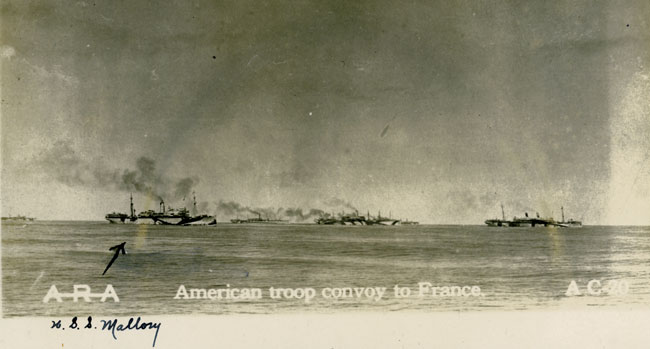


5th Battalion, 20th Engineers
The Fifth Battalion
Note: Most of the text of this article comes from "TWENTIETH ENGINEERS -- FRANCE -- 1917-1918-1919"
The nucleus of the Fifth Battalion began to form at Camp Belvoir, Virginia, as soon as the Third and Fourth were brought to strength. The three companies, A, B, and C, were organized December 5th, 1917, and Headquarters Detachment was formed a week later. At this period, recruiting for the Twentieth was in full swing all over the country, and completion of the organization to strength found all sections, and nearly every state, represented, the Northwest and Pacific Coast furnishing the largest quotas.
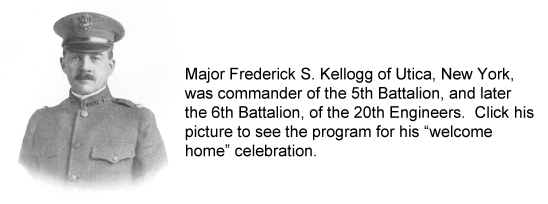
Six weeks of training, equipping, and heavy fatigue duties found the Battalion ready for overseas service. Plans for the construction of a huge Engineer cantonment had been completed in November, and it fell to the lot of the outfit to make a preliminary clearing, and build a plank road from Belvoir to the new camp, later designated as Camp Humphreys. The work was put through during the worst of that exceptionally bad winter, most of the time under zero weather.
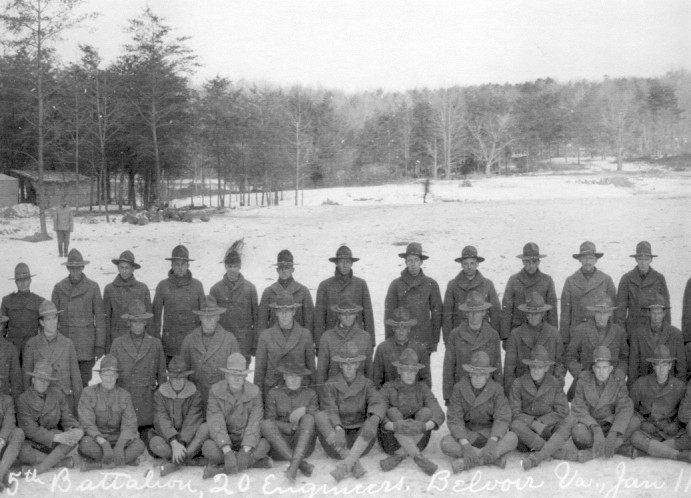
Partial photo of Company C, 5th Battalion, 20th Engineers at Camp Belvoir
Click to see additional photos of the entire company
The unit was reported ready for departure January 10th, and orders came for its embarkation, in company with our Sixth Battalion. Four days later a case of meningitis appeared, and the ensuing quarantine cancelled the program, thus saving the outfit from sharing the fate of the Sixth, in the "Tuscania" disaster.
January 25th, 1918, the Fifth marched to Mount Vernon, and entrained for Washington, where they occupied the barracks vacated by the Sixth, while final preparations were completed. At 4 P. M., January 29th, the Battalion hit the long, long trail, the first stretch being a march to the troop train at Roslyn, in a driving blizzard.
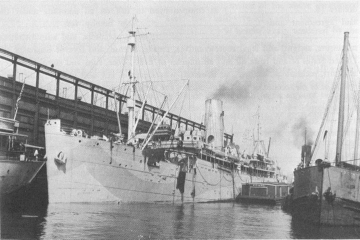
At six the next morning the outfit detrained at Jersey City, cramped and numb from the all - night ride in unheated cars. By noon the companies had all gone up the gangplank of U.S.S. "Calamares,'' a 6,000 ton converted freighter. The Battalion as checked on the pier, consisted of 758 men and and 19 officers.
At 7 P. M., January 31st, the ''Calamares'' nosed out of the harbor and joined a convoy consisting of a U. S. armored cruiser and the transports ''Oealis'' and "Wilhelmina." The voyage was stormy but otherwise uneventful, except for a submarine alarm early the last morning of the trip. No action resulted, and the actual attack of an enemy is to this day debatable. At 9:30 [16 Jan?] the transport anchored in the roadstead of Brest.
Sunday, February 17th, the Battalion debarked, and marched through the principal street of Brest to Pontenezan Barracks. After two days of acclimatization, the inevitable happened; the organization was broken up, and the companies started for their posts of duty.
Headquarters of the Battalion had been designated to assume direction of a new district in the valley of the Loire, 100 miles south of Paris. Administration offices were installed in the important town of Gien; and Co.s A and B, later named the 13th and 14th Co.s, were assigned to operate in the district.
Battalion Commander and Staff
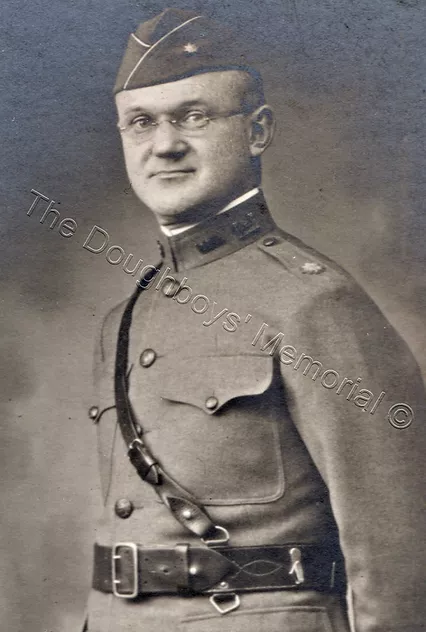
Major Robert Y Stuart Battalion Commander |
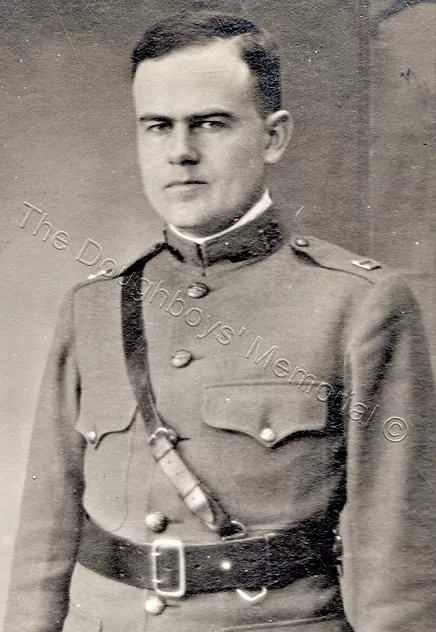
Captain Warren T Smith Battalion Staff |
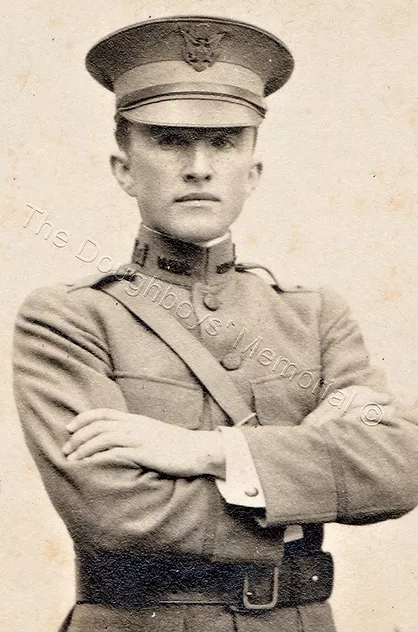
Captain Milton B Whiting Battalion Staff |
|---|---|---|
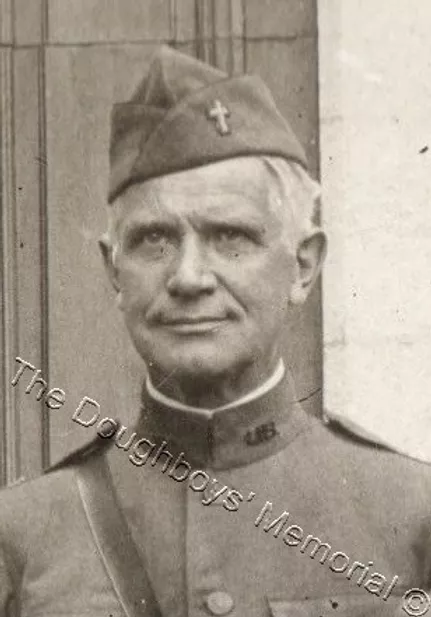
Lieutenant James Small Battalion Chaplain |
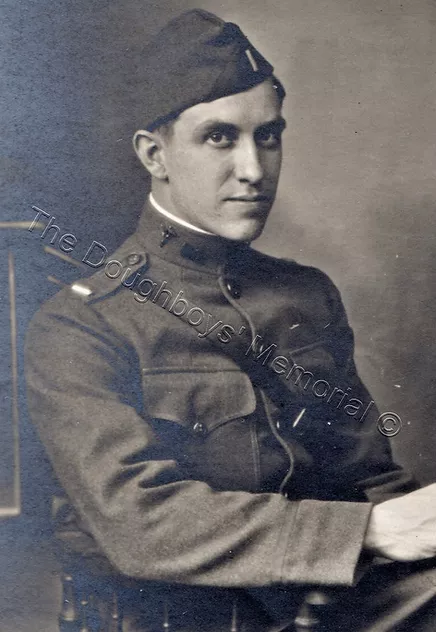
Lieutenant Francis E Worch Battalion Veterinarian |
The 13th Co. was sent to the village of Brinon-sur-Sauldre, Cher, where they erected an American sawmill of 10,000 foot capacity. The operation assumed large proportions within a few weeks, and a service company of colored troops were assigned to assist in lumber and fuel handling. At the time of the Armistice the camp had a strength of 506 officers and men. The 13th was represented for a time by a detachment at Mauny, northeast of Brinon, where round timbers were produced, but the operation was temporary.
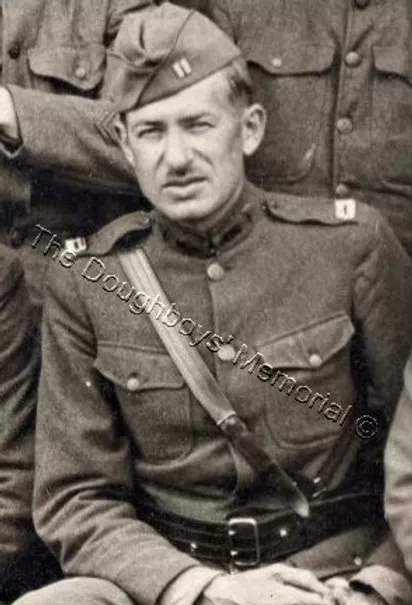
Captain William F Maertz Company Commander 13th Company |
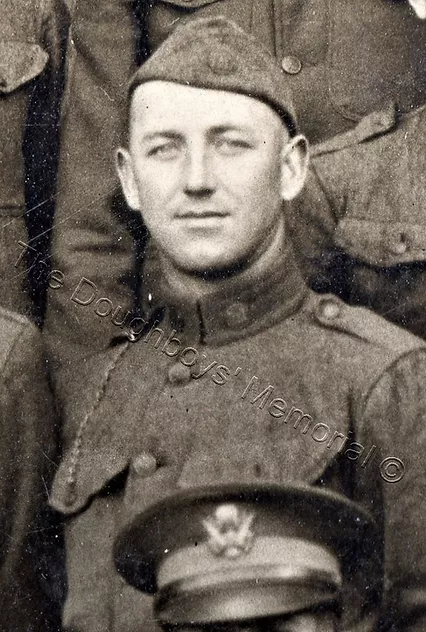
Sergeant Arthur S Holmes 13th Company |
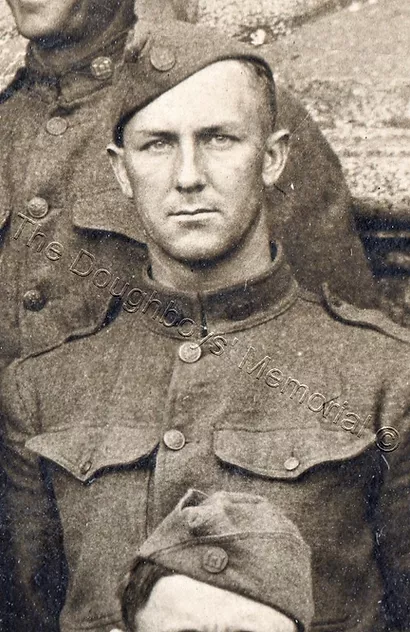
Sergeant Russell H Holmes 13th Company |
|---|
Co. B. later the 14th Co., left Pontenezan Barracks alone for their post of duty at Subligney-Villeroy, in the Department of Yonne. Here they erected an American mill, and commenced logging in the Foret de Bruneau. The timber was chiefly oak. Within a month the activities of the unit were widened, two detachments of 40 men each proceeding to new operations at Urzy and Moulins-Engibert, Nievre. Mills were built at both camps, and the personnel of the three operations increased by the arrival of Co. C, 43rd Engineers, and by detachments from the 6th, 12th, and 24th Service Co.s of the Twentieth, Co. C of the 548th Engineers, and Battery A of the 48th Regiment of Coast Artillery.
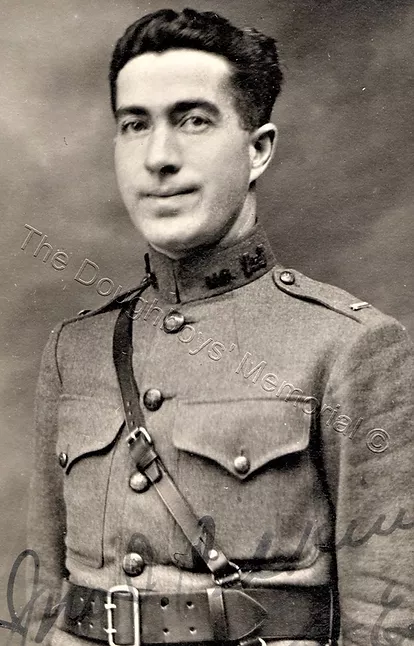
Lieutenant John L Pilkington
14th Company
A further development of the territory led to the opening of a piling and tie camp at Mauny, Yonne, manned by detachments of the 14th and 13th Co.s, and a later detail from the 48th Co.
Production at all the operations was uninterrupted until after the Armistice, when the imminent departure of our senior Battalions, the former Tenth Engineers, caused the assignment of the 14th Co. to take over the duties of the 36th Co. In January 1919, the Urzy detachment moved to the nearby camp at Donzy, and a few weeks later the remainder of the outfit took over the mill at Mortumier, near district headquarters at Gien.
Homecoming preparations took form in April, when the Company was assembled at Subligney, whence they left May 10th for the Nantes billeting area and spent a week with the re-united Fifth Battalion. The 15th Co. drew the lucky number embarking May 18th, the rest of the Battalion, consisting of Headquarters and the 13th and 14th, being held till when they boarded the transport "Princess Matoika." The voyage gave the veterans a glimpse of southern skies; the outfit was landed at Charleston, South Carolina, June 23rd, and broken into home detachments at Camp Jackson. The Company organizations were sent to Camp Lewis, on account of the pre-dominant number of westerners, and there the final muster out occurred early in July.
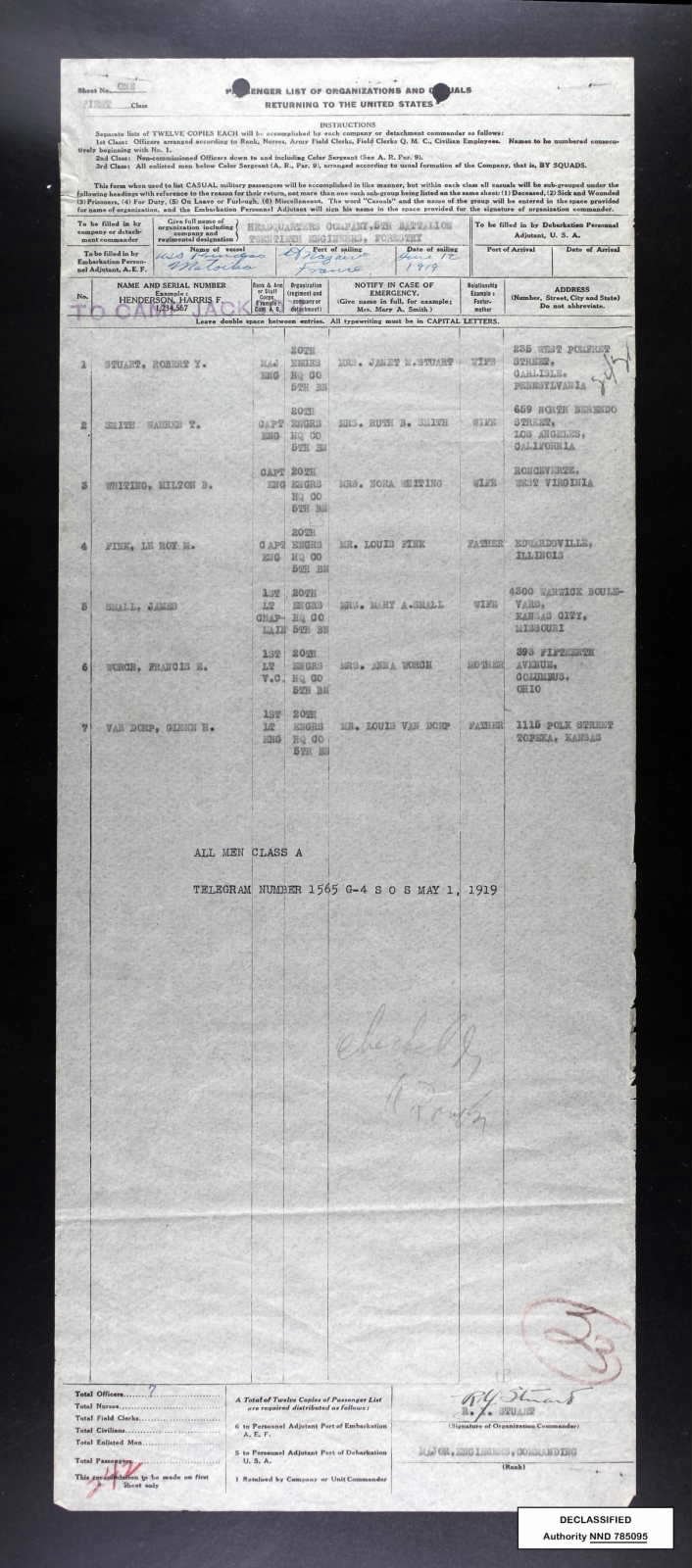
Princess Matoika passenger list showing 5th Battalion Commander and Staff
Co. C, later designated as the 15th Co., was separated from the Battalion at Brest, and ordered to the Epinal District, under the Second Battalion organization. February 23rd, 1918, they arrived at their station—the town of Chatenois, nine miles east of Neufchateau, Vosges. Here the company relieved a detachment of the Second Battalion, logging and operating a mill of dubious ancestry.
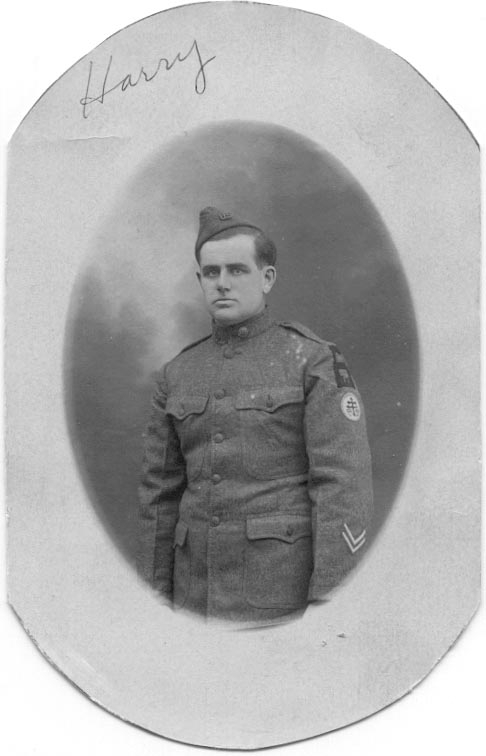
Private First Class Harry Byron Schriever
Company C, 5th Battalion, [15th Company], 20th Engineers
Click to see the story and additional photos of Harry Schriever
Early in April the 15th Co. was reinforced by the 38th, originally Co. A of the 41st Engineers. The combined force rapidly extended their activities; a detachment of 125 men took over a French mill at Hortes, in Haute Marne; a tie camp, with a force of 40, was started at Merrey; and a more pretentious operation was commenced at Lamarche, manned by 125 of the Chatenois outfit and a Company of colored service troops.
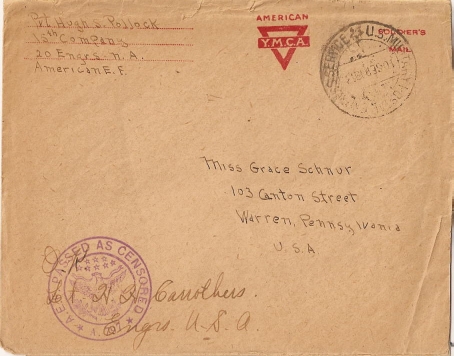
Letter from Private Hugh S. Pollock, 15th Company
Note the censor's stamp on the envelope.
In June the unit was further deployed; their first American mill, of 10,000 ft. capacity, was built at Gironcourt, and a tie camp established at Bazoilles, a hospital center near Neufchateau. The Hortes and Merrey forces were assigned to Gironcourt upon the completion of their cuts, and a vigorous start was launched when orders came through detaching the 15th Co. from Epinal District.
Plans for the great American offensive at St. Mihiel were rapidly crystallizing, and to further the supply of needed timbers the outfit was attached to the First Army--the first actual detail of Twentieth Engineers to combat forces.
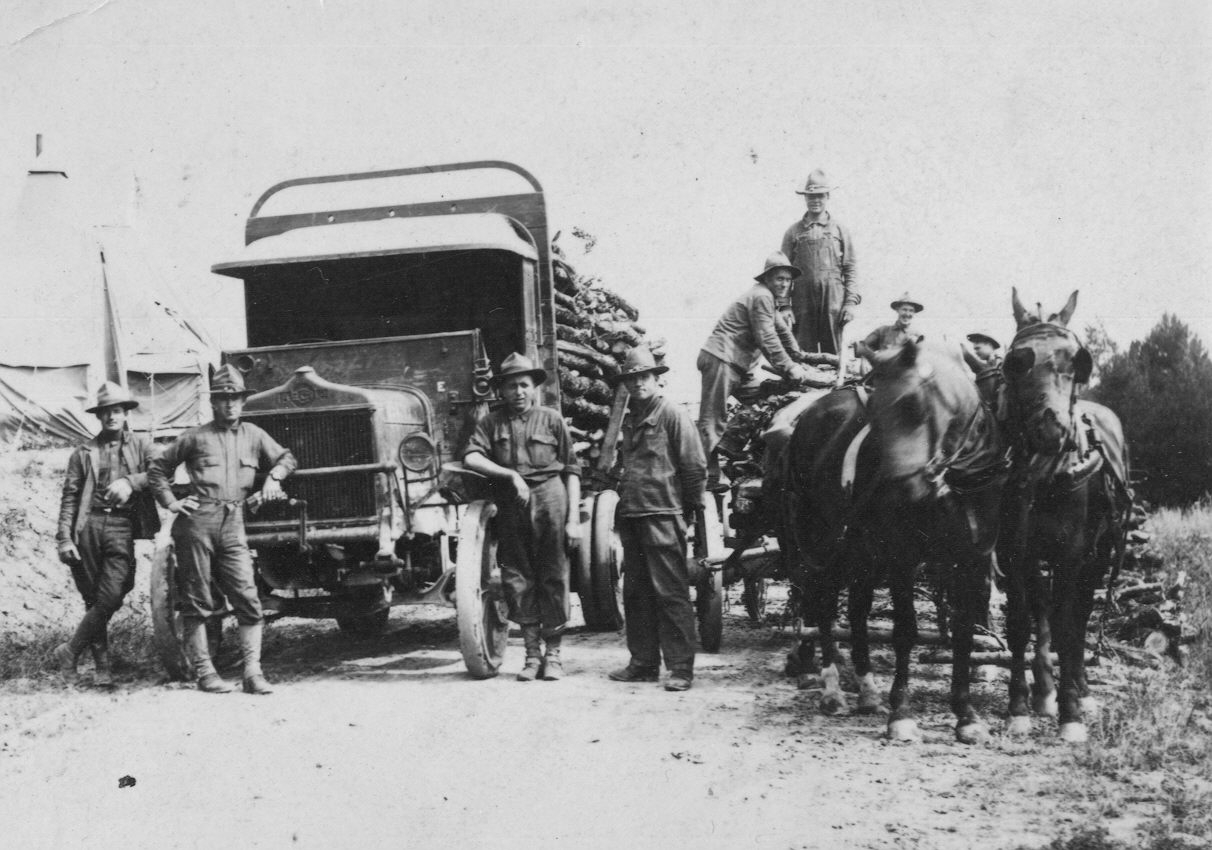
Work Detail from Company C, 5th Battalion, [15th Company], 20th Engineers
Photo courtesy of Byron Schriever, son of Pvt. 1st Cl. Harry Byron Schriever
The Company left August 28th, 1918, for their new base at Toul. Their duties from now till the Armistice was to consist of many small and temporary operations, located with respect to the strategic situation, and following the victorious sweep of our First and Second Armies. The duties of the detachment brought several of the camps under intermittent enemy fire. Both at Menil-la-Tour and Marbache, bombardments occurred repeatedly. The latter camp was the recipient of about forty German shells in one afternoon, several of which exploded in the yard. Three French soldiers were killed by an exploding bomb, just in front of the mill, but the Twentieth escaped without casualties.
The Ippecourt detachment suffered the only action deaths of the unit, when Captain McPherson, 38th Co., and Lieutenant Fair, Medical Corps, were killed by enemy machine gun fire, while locating a new mill site near Varennes, October 5th.
Other temporary operations in the Army Zone, during the St. Mihiel and Argonne drives, were located at Liverdun, Scirie de Haye, Benoite Veaux, Domgermain, Commercy, Les Islattes, Croix de Pierre, Puvenelle, and Souilly. The constant advance of the fighting line called for unflagging energy in pushing forward the forestry forces. Several of the camps were thrust into ground newly taken from the enemy, and augmented strength for the timber-handling forces was drawn from the Epinal district. Quartermaster detachments were drawn upon, and broad plans for further penetration of the new ground were under way, when the Armistice called a halt.
November 18th, orders issued for a cleanup of the jobs still operating, and the work was completed three weeks later. The scattered units of the 15th Co. reassembled at the home camp of Chatenois, December 16th, and took up the mundane duty of getting out fuel for the combat troops at ease in the neighboring billets.
Early in January, in accord with established, but later discredited, plans, the Co. was released from duty. On the 12th they entrained for the coast, and three days later reached the billeting area at Boussay, 30 miles south east of Nantes. Two days later they were suddenly shifted to Nantes, where the news was broken that our Regimental priority had been sunk without trace and several months of A. E. F. duty were still ahead.
From January 18th until May 1st the company toiled on the highways along the Loire, centering in the town of Ancenis, 25 miles above Nantes. Completion of the job was followed two weeks of drill, and May 13th the unit returned to Nantes and rejoined the Fifth Battalion for the homeward journey,
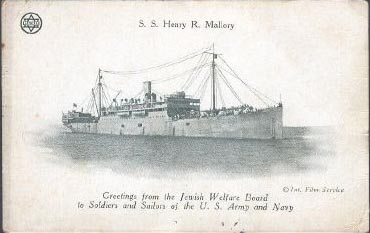
The Battalion was scheduled for sailing as a unit, but the unexpected development of space in the hold of the transport ''Henry R. Mallory'' gave the 15th Co. its opportunity, and after a hurried purification ceremony, the unit embarked May 17th, 1919. The vessel sailed before sunrise the next morning, and after a wild and stormy trip, docked at Brooklyn May 28th. Two days later the Company officially disappeared from the Army lists, and its members scattered to the four corners of America, after a year and a half of perhaps the most varied military service that ever came to a unit of the American Army. At the front, in the lines of communication, down on the Loire—lumbering, road building on two continents, in contact with all the service branches, the 15th Co. had its share.
